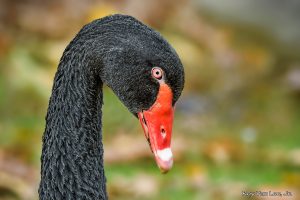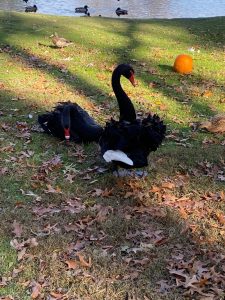If you have recently visited our W.K. Kellogg Bird Sanctuary, you may have noticed some new residents near the lake. You may have first noticed a flurry of high-pitched peeping as you walked the  path up to our Diver Pond. Maybe you heard a whistle, or a duet of both sounds sung out as you looked out to see two streaks of shimmering black, dotted with flashes of red, dart from the middle of the pond to the bank. As they climb the bank, and awkwardly make their way to the fence to say hello, they continue their duet of whistles and peeps. You notice something breathtaking about their feathers as they make their way over. Their wings are lined with primary feathers that are curled as if they’d spent hours getting ready in front of the mirror. You have just met Mr. Black and Violet, our Australian Black Swan pair.
path up to our Diver Pond. Maybe you heard a whistle, or a duet of both sounds sung out as you looked out to see two streaks of shimmering black, dotted with flashes of red, dart from the middle of the pond to the bank. As they climb the bank, and awkwardly make their way to the fence to say hello, they continue their duet of whistles and peeps. You notice something breathtaking about their feathers as they make their way over. Their wings are lined with primary feathers that are curled as if they’d spent hours getting ready in front of the mirror. You have just met Mr. Black and Violet, our Australian Black Swan pair.
Australian Black Swans (Cynus atratus) are one of three swan species native to the Southern Hemisphere, and the only known black colored swan species on Earth. These large waterfowl can weigh up to 20 lbs (9kg), with males being the larger sex of the species. Black Swan populations can natively be found across Eastern and Western Australia, feeding on whatever aquatic vegetation they may find. They may be found on either fresh or saltwater, and often thrive in either. Black Swans have been introduced in New Zealand, Japan, and a few different parts of Europe, including the U.K. Across the world, Black Swan populations are estimated to be around 500,000 individuals. In the United States, it is extremely rare to see this bird outside of captivity. More often than not, if you spot a Black Swan in a U.S body of water, it escaped from whoever was trying to keep it privately. For example, it was just last year that Black Swans who’d evaded captivity were spotted (and safely recovered) in the Santa Barbara harbor!
populations can natively be found across Eastern and Western Australia, feeding on whatever aquatic vegetation they may find. They may be found on either fresh or saltwater, and often thrive in either. Black Swans have been introduced in New Zealand, Japan, and a few different parts of Europe, including the U.K. Across the world, Black Swan populations are estimated to be around 500,000 individuals. In the United States, it is extremely rare to see this bird outside of captivity. More often than not, if you spot a Black Swan in a U.S body of water, it escaped from whoever was trying to keep it privately. For example, it was just last year that Black Swans who’d evaded captivity were spotted (and safely recovered) in the Santa Barbara harbor!
Here at the Sanctuary, Mr. Black and Violet have their flight feathers trimmed so that they do not become vagrants! Our pair were donated from a private collection, and have lived together almost all of their lives! Both Mr. Black and Violet were hatched in 2011 which makes them 10 years old right now! Violet was hand reared from hatching, so she is often the first to say hello as you pass by, but Mr. Black loves to greet you too! If you come for a visit, and would like to know who is who there are a couple good indicators to look for! If the pair are standing together, Mr. Black is the larger of the two. If they have come to say hello to you near the fence, you can look at their bills to check for the next indication! Mr. Black has a dark marking we like to call his mustache which breaks up the white stripe across his red bill, while Violet’s stripe is just white. As the pair gets used to life here, they can be seen taking lots of baths, running up to the fence to greet guests, and now they are even starting to realize that corn is a tasty treat!
The Black Swans are currently off exhibit during this cold and snowy weather, but we will expect them to go back out on exhibit soon!
Brenden Kokx is the Avian Caretaker for the W.K. Kellogg Bird Sanctuary. He graduated from Michigan State University in 2020 with a B.S. in Fisheries and Wildlife Management.

A legacy of conservation; a commitment to sustainability.
Kellogg Bird Sanctuary12685 East C Avenue
Augusta, MI 49012
Phone: (269) 671-2510 birdsanctuary@kbs.msu.edu